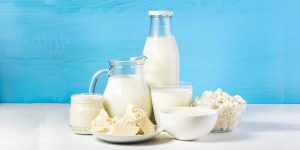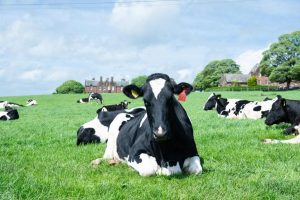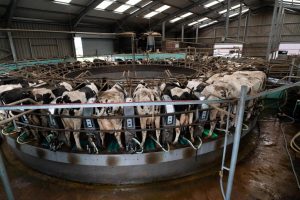
After completing the National Certificate in Agriculture at CAFRE Enniskillen Campus, Co. Fermanagh, he returned home to the family dairy farm, at Ballykeel, on the outskirts of Sixmilecross.
Over recent years, the dairy herd size has grown from 70 cows to its current 124 Holstein Friesians.
Cow-welfare friendly system
Farm development work has focused on improving cow accommodation, handling, and milking facilities.
This has been “positively reflected” in the key performance indicators of milk from forage, milk yield/cow and concentrate feed efficiency.
Last year, the herd’s benchmarking performance showed an average of 7,588 litres of milk per cow with a protein content of 3.30% and a butterfat content of 4.16%.
Concentrate usage was 2,807 kg/cow with 1,351 litres of milk produced from forage, the data shows.
Cow management
Due to land type (primarily heavy clay), high rainfall (59 inches in 2021), and limited land available for grazing around the dairy, Ronan has opted for block autumn/winter calving, which “eases” cow management.
Furthermore, with cows calving during the closed slurry spreading period and a quieter time for field work, Ronan can focus on the dairy herd and manage labour.
The other advantage Ronan sees with block calving is having one batch of replacement heifer calves to manage.
BDG
Ronan has been a member of a Dairy Business Development Group (BDG) – which Jane Sayers, local CAFRE dairying adviser, oversees in the Sixmilecross area for the last five years.
Through attending meetings and visiting other farmers, Ronan has gained a greater knowledge of practices and technologies.
As a result, he said he has been able to adopt on his home farm to help him improve efficiencies and develop his own farm business.
Grazing infrastructure
One such result is the development of an “excellent” grazing infrastructure to maximise the utilisation of grazed grass.
Since early April, an 84-strong group of low-yielding cows have been at grass during the day, housed at night and fed a total mixed ration of 25 kg silage fresh-weight and 5 kg blend. Cows are now on their third grazing rotation.
He reports that graze outs have been “good”. However, some stem is appearing, and as a result, he has to top these paddocks.
The dairy farmer will spread 1 bag of 27%N/acre after cows graze each paddock. A smaller group (40 cows) of higher-yielding cows are housed full-time.
According to data for the farm, the current average milk yield is 28 litres/cow/day.
This year, grass has been difficult to manage, and supplies were “tight” in May. He cited cold nights, poor grass growth and having silage ground closed up as the primary reasons for this.
However, he has extended the grazing rotation and allowed a grass wedge/surplus to build up.
He has achieved this by incorporating silage aftermaths into the grazing platform and removing some cows from the herd (drying off).
Providing weather, grass and ground conditions are “good”, he hopes to keep cows out on grass during the day until early November.
Inclement weather conditions resulted in a day for first-cut silage harvesting until late May. Ground for second cut silage has received 2,500 gallons/acre (28 m3/ha) of slurry and 2 bags/acre of 24.0.13.
Labour efficiency
Improving labour efficiency on-farm is a long-term goal of Ronan’s. To pay the way for this, he has adopted labour-saving technologies.
To date, these have included a cow heat detection system and a heifer synchronisation breeding programme.
He says that such technologies have enabled him to have more time to spend with his wife and young family and improve milk production efficiency.






















